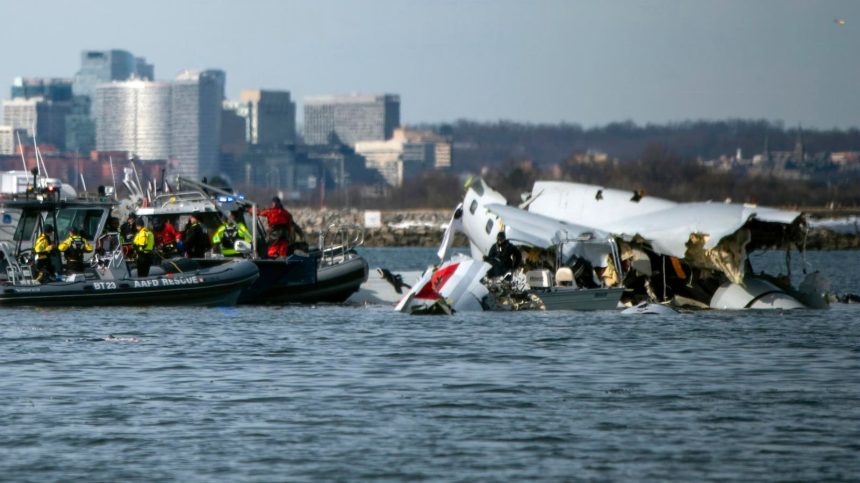The Reagan Airport Mid-Air Collision: A Tragedy Unfolds
On Wednesday, January 29, 2024, tragedy struck the skies near Ronald Reagan National Airport in Washington D.C. when a Bombardier CRJ700 regional jet, operated by PSA Airlines for American Airlines, collided with a U.S. Army Black Hawk helicopter. The collision, occurring shortly before 9 p.m. local time, resulted in the deaths of all 67 individuals on board both aircraft – 64 on the plane and three on the helicopter. The passenger jet, originating from Wichita, Kansas, was approaching the runway for landing when the collision occurred. The Black Hawk helicopter, carrying three crew members, was conducting a routine night evaluation flight. The crash sent shockwaves across the nation, marking the first fatal crash of a U.S. commercial airliner since 2009 and the deadliest aviation disaster since 2001. The incident immediately prompted a multi-agency response, with hundreds of emergency responders rushing to the scene despite challenging weather conditions. The recovery operation was hampered by the Potomac River’s strong currents and low visibility.
Unraveling the Events: Timeline of the Disaster and its Aftermath
The immediate aftermath of the crash was marked by confusion and grief. Initial reports struggled to ascertain the exact number of casualties, with authorities confirming the lack of survivors by Thursday morning. The recovery of bodies and aircraft debris became the immediate priority, with divers braving the harsh weather conditions in the Potomac River. The National Transportation Safety Board (NTSB) launched a comprehensive investigation, securing the plane’s cockpit voice recorder and flight data recorder, often referred to as "black boxes." As details emerged, the scope of the tragedy became clearer. The passenger list revealed a heartbreaking cross-section of American life, including a group of young figure skaters from the Skating Club of Boston returning from a training camp, two Chinese nationals, a police official from the Philippines, and several friends on their way back from a Kansas hunting trip. The Army identified two of the three Black Hawk crew members as Staff Sgt. Ryan Austin O’Hara and Chief Warrant Officer 2 Andrew Loyd Eaves, while the third crew member’s identity remained withheld at the family’s request.
Controversy and Speculation: The Search for Answers
The crash sparked immediate speculation about the cause, with former President Donald Trump quickly weighing in on social media and in subsequent press briefings. Trump criticized air traffic control, the helicopter pilots, and even invoked Obama and Biden-era diversity hiring practices within the FAA as potential contributing factors, drawing sharp criticism from officials like former Transportation Secretary Pete Buttigieg, who labeled Trump’s statements "despicable." Trump’s comments, made before any official investigation findings were released, highlighted the politically charged atmosphere surrounding the tragedy and fueled public debate. Reports also emerged regarding potential staffing issues at the air traffic control tower at Reagan National Airport, with some suggesting that a single controller was handling both helicopter and plane traffic, a task usually assigned to two controllers. However, these claims were disputed by other sources. Further adding to the complexity, a near-miss incident involving a passenger plane and a military helicopter in the same area just a day before the fatal crash came to light, raising questions about potential systemic issues in the airspace around the airport.
The Investigation Unfolds: Seeking Clarity Amidst the Chaos
As the investigation progressed, the FAA implemented new, indefinite restrictions on helicopter traffic near Reagan Airport, limiting certain air traffic routes and prioritizing police and medical helicopters. The recovery of the Black Hawk’s black box remained a key objective to understand the helicopter’s flight path and actions leading up to the collision. Preliminary reports revealed that the helicopter was flying "far above" its designated flight path, adding another layer of complexity to the investigation. The NTSB continued its meticulous work, analyzing the recovered flight data recorders and interviewing witnesses. Their focus remained on determining the sequence of events, communication between the aircraft and the air traffic control tower, and any potential contributing factors, including environmental conditions, human error, or mechanical failure.
The Human Cost: Remembering the Victims
Beyond the technical aspects of the investigation, the human cost of the tragedy remained at the forefront. The figure skating community mourned the loss of several prominent members, including coaches and young athletes. Families and friends of the other victims grappled with their grief, sharing stories of loved ones lost too soon. The crash served as a stark reminder of the fragility of life and the devastating impact of such unexpected events. Memorial services and tributes were held across the country to honor the victims and offer support to their families.
The Path Forward: Preventing Future Tragedies
The Reagan Airport mid-air collision underscored the critical importance of air safety protocols and the need for continuous improvement in aviation safety measures. The NTSB’s investigation, expected to take months to complete, will hopefully shed light on the precise causes of the crash and lead to actionable recommendations for preventing similar tragedies in the future. The incident also prompted a broader conversation about the challenges facing the aviation industry, including staffing shortages, the complexity of airspace management, and the ongoing need for enhanced safety technologies and procedures. The lessons learned from this tragic event will undoubtedly shape the future of aviation safety and serve as a lasting legacy to the 67 lives lost.



